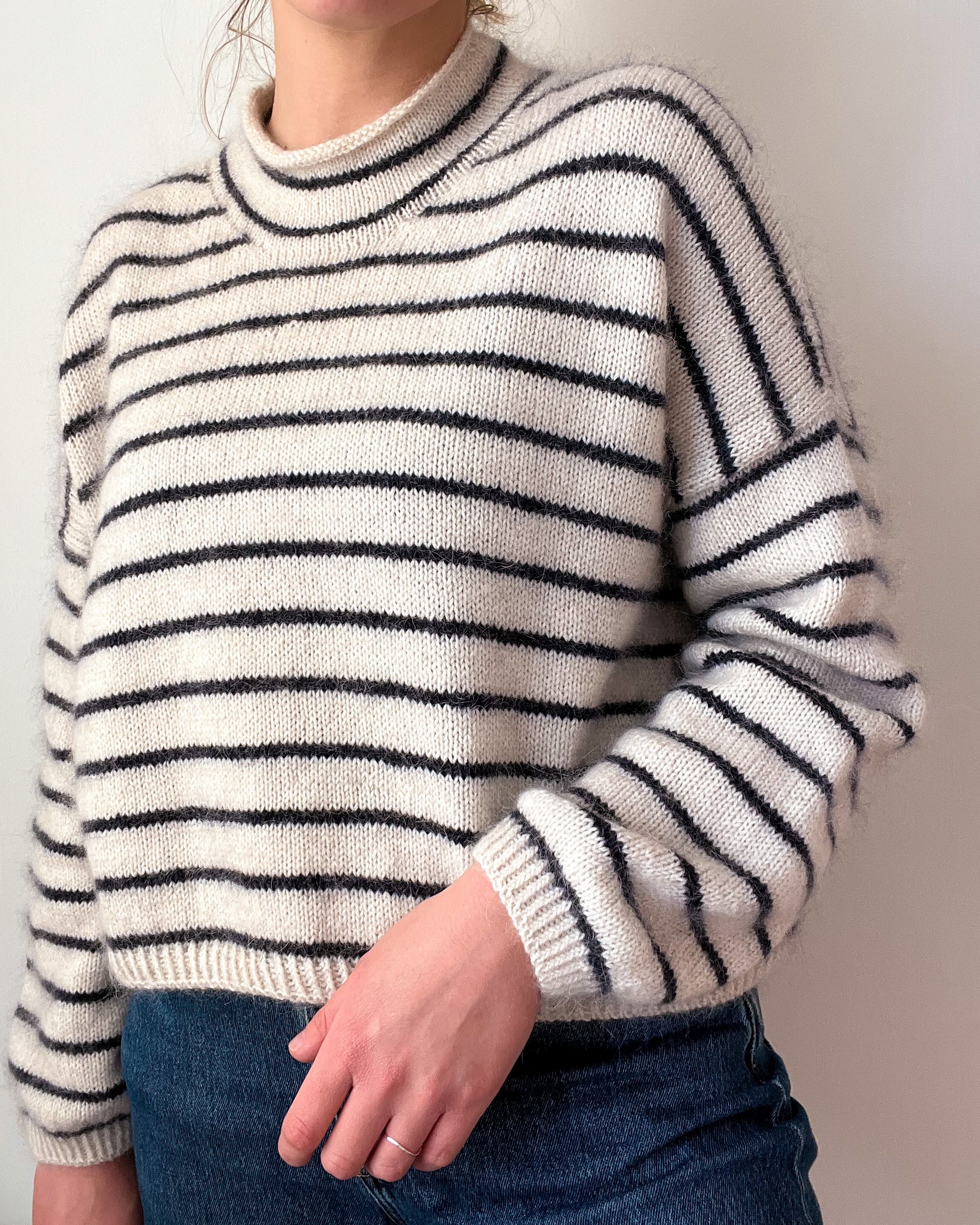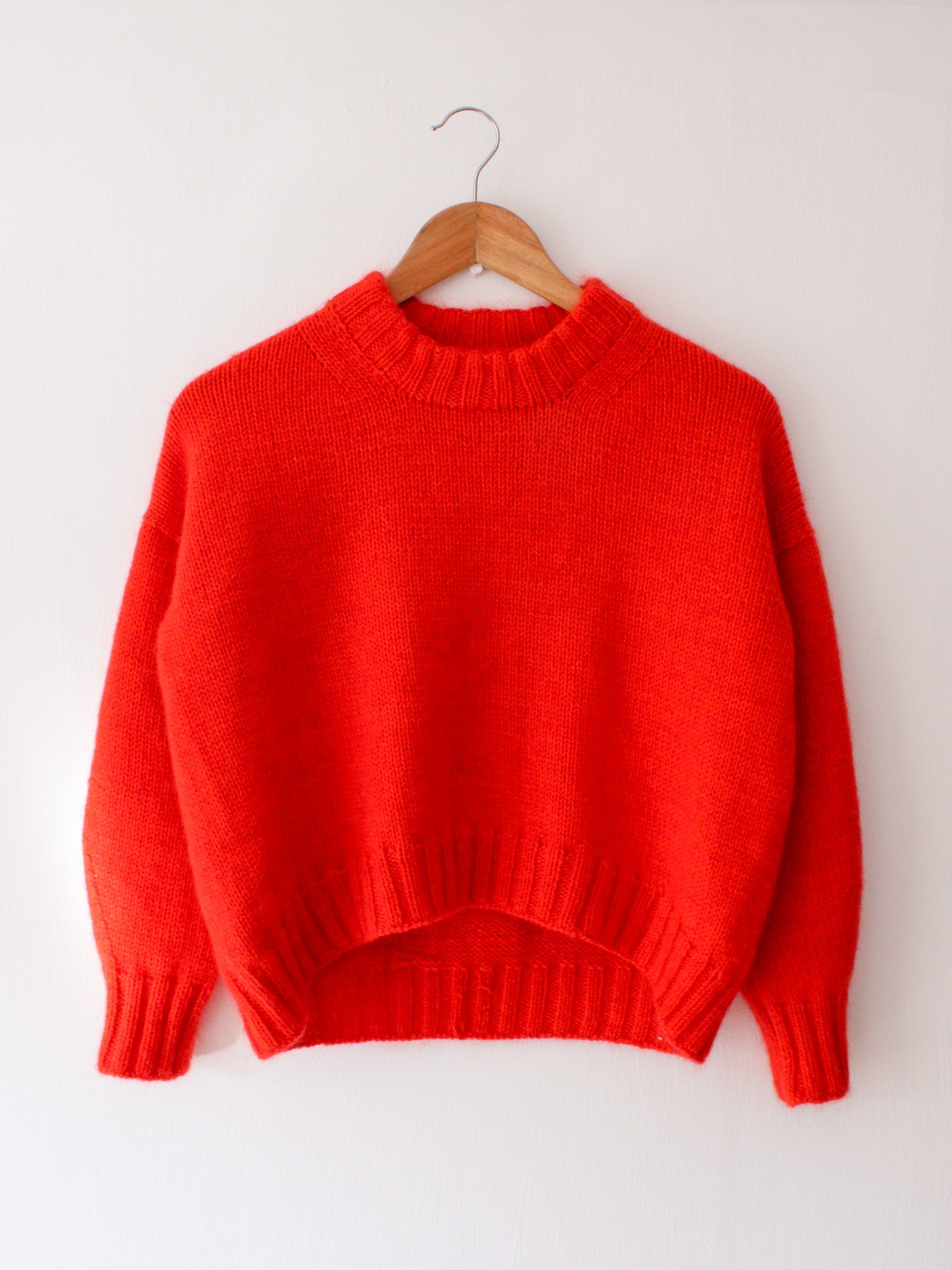Tendreil Sweater
The Tendreil Sweater is a slightly oversized drop-shoulder sweater with lightning-bolt cables ('tendreil' is the Manx Gaelic word for 'lightning') on the front panel. The sweater is worked top down, both flat and in the round. The fit is very relaxed and slouchy, and the sleeves have a slight taper with a loose fit around the wrists. The back panel is worked first with some simple shaping to create sloping shoulders. Once the back panel is worked, the stitches are left to rest, and you will move on to work the shoulders. The left shoulder is worked first with the cable motif and some shoulder shaping, and you repeat this process for the right shoulder. Then you join the two shoulders together and work the front panel to the same depth as the back panel whilst continuing the lightning motif. Next, you will join the front and back panels together to be worked in the round until you are happy with the length, and then work the hem. Next, you pick up and knit the stitches for each sleeve, working decreases to give the sleeves a little bit more shape. To finish, you pick up and knit the double-folded collar.
You are welcome to modify the lightning-bolt cables to suit your preferences. There are two placement options within the pattern (either framing the collar or falling over the shoulders), and you can continue to work them for as far into the body as you would like. You can also go for either a regular or a split hem. The pattern has options for both.
This pattern also includes a modification for a V-neckline. This is at the end of the pattern and, if you wish to make this option, it is very important that you read the notes for the modification on pp. 27-31 before you start working the front panels.
The Tendreil Sweater has been tech edited and test knitted. For pattern support, please contact me by email. Please note that this is a pdf download and not a physical knitting patttern.
The Tendreil Sweater is a slightly oversized drop-shoulder sweater with lightning-bolt cables ('tendreil' is the Manx Gaelic word for 'lightning') on the front panel. The sweater is worked top down, both flat and in the round. The fit is very relaxed and slouchy, and the sleeves have a slight taper with a loose fit around the wrists. The back panel is worked first with some simple shaping to create sloping shoulders. Once the back panel is worked, the stitches are left to rest, and you will move on to work the shoulders. The left shoulder is worked first with the cable motif and some shoulder shaping, and you repeat this process for the right shoulder. Then you join the two shoulders together and work the front panel to the same depth as the back panel whilst continuing the lightning motif. Next, you will join the front and back panels together to be worked in the round until you are happy with the length, and then work the hem. Next, you pick up and knit the stitches for each sleeve, working decreases to give the sleeves a little bit more shape. To finish, you pick up and knit the double-folded collar.
You are welcome to modify the lightning-bolt cables to suit your preferences. There are two placement options within the pattern (either framing the collar or falling over the shoulders), and you can continue to work them for as far into the body as you would like. You can also go for either a regular or a split hem. The pattern has options for both.
This pattern also includes a modification for a V-neckline. This is at the end of the pattern and, if you wish to make this option, it is very important that you read the notes for the modification on pp. 27-31 before you start working the front panels.
The Tendreil Sweater has been tech edited and test knitted. For pattern support, please contact me by email. Please note that this is a pdf download and not a physical knitting patttern.
The Tendreil Sweater is a slightly oversized drop-shoulder sweater with lightning-bolt cables ('tendreil' is the Manx Gaelic word for 'lightning') on the front panel. The sweater is worked top down, both flat and in the round. The fit is very relaxed and slouchy, and the sleeves have a slight taper with a loose fit around the wrists. The back panel is worked first with some simple shaping to create sloping shoulders. Once the back panel is worked, the stitches are left to rest, and you will move on to work the shoulders. The left shoulder is worked first with the cable motif and some shoulder shaping, and you repeat this process for the right shoulder. Then you join the two shoulders together and work the front panel to the same depth as the back panel whilst continuing the lightning motif. Next, you will join the front and back panels together to be worked in the round until you are happy with the length, and then work the hem. Next, you pick up and knit the stitches for each sleeve, working decreases to give the sleeves a little bit more shape. To finish, you pick up and knit the double-folded collar.
You are welcome to modify the lightning-bolt cables to suit your preferences. There are two placement options within the pattern (either framing the collar or falling over the shoulders), and you can continue to work them for as far into the body as you would like. You can also go for either a regular or a split hem. The pattern has options for both.
This pattern also includes a modification for a V-neckline. This is at the end of the pattern and, if you wish to make this option, it is very important that you read the notes for the modification on pp. 27-31 before you start working the front panels.
The Tendreil Sweater has been tech edited and test knitted. For pattern support, please contact me by email. Please note that this is a pdf download and not a physical knitting patttern.
Materials & Fit
Notions: 4 mm [US 6] (40- and/or 60- cm [16- and/or 20-in] 80- and/or 100-cm [32- and/or 40-in] cord) and 5 mm [US 8] (80-, and/or 100-cm [24-, 32-, and 40-in] cord) circular needles, and some 3.5 mm [US 4] circular needles to finish off the collar. You will also need a few stitch markers, a darning needle, and some spare needles/scrap yarn/stitch holders where the back panel will rest. At least 2 of the stitch markers should have a clip-on mechanism to help you keep track of your progress, especially when mapping out the back shaping.
Yarn: Approximately 850 (925) 950 (1,000), 1,100 (1,150) 1,200 (1,250), 1,300 (1,350) 1,400 (1,450) m [950 (1,025) 1,050 (1,100), 1,200 (1,250) 1,325 (1,375), 1,425 (1,475) 1,550 (1,575) yds] of a DK-/aran-weight yarn (e.g., Sandnes Garn Peer Gynt, Sandnes Garn Double Sunday, or Knitting for Olive Heavy Merino) held with the same quantity of a lace-weight yarn (e.g., Sandnes Garn Tynn Silk Mohair, Knitting for Olive Soft Silk Mohair, CaMaRose Midnatssol, Filcolana Tilia). I have rounded these quantities to the nearest 25 m/yd. They are based on tester feedback and my samples, and I have tried to be generous to avoid potential issues with dyelots. I found I needed slightly more yarn to make my V-neck sample; this has been taken into account in the yardage.
If you were to use Sandnes Garn Peer Gynt (50 g = 91 m [100 yds]; 100% Norwegian wool), you would need 10 (11) 11 (11), 12 (13) 13-14 (14), 15 (15) 15-16 (16) balls of yarn. If you were to hold this with Sandnes Garn Tynn Silk Mohair (25 g = 212 m [232 yds]; 57% mohair, 15% wool, 28% silk) , you would need 4-5 (5) 5 (5), 6 (6) 6 (6), 7 (7) 7 (7) balls of yarn.
Tension: 17 sts x 24 rows and rounds in Stockinette stitch on 5 mm [US 8] needles = 10 x 10 cm [4 x 4 in]. Make sure to wash and block your swatch for the most accurate results. Please note that I have tighter-than-average row gauge, but this isn’t too important in this pattern. You may wish to go up or down a needle size, working in 0.25/0.5 mm increments as needed, to meet gauge.
You may also wish to make a swatch practicing the cable pattern. It isn't too difficult but if you're less experienced working cables or reading charts, it might be worth taking the time to practice over a smaller piece of knitting. Please note that the quantities of yarn given above in metres and yards should include these swatches as, again, I’ve erred on the side of being generous with yardage.
Sizing and ease: The Tendreil Sweater has a recommended positive ease of 21-33 cm [8.25-13 in] around the chest (or the widest part of your torso). If you want a tighter fit, you should feel free to pick a size with less positive ease relative to your body using the measurements given below, and vice versa. If in doubt, I recommend measuring a garment you already own that is also oversized and using that as a guideline to help you find your preferred fit.
Size: A (B) C (D), E (F) G (H), I (J) K (L)
Chest measurement (cm): 75-80 (80-85) 85-90 (90-95), 95-100, (100-105) 105- 110 (110-115), 115-125 (125-135) 135-145 (145-155)
Chest measurement (in): 29.5-31.5 (31.5-33.5) 33.5-35.5 (35.5-37.5), 37.5-39.25 (39.25-41.25) 41.25-43.25 (43.25-45.25), 45.25-49.25 (49.25-53.25) 53.25-57 (57-61)
Actual circumference of garment (cm): 101 (106) 113 (117.5), 122.5 (127) 134 (139), 148 (157.5) 167 (176.5)
Actual circumference of garment (in): 39.75 (41.75) 44.5 (46.25), 48.25 (50) 52.75 (54.75), 58.25 (62) 65.75 (69.5)
Actual yoke depth at outer edges of the yoke (cm): 18 (18.5) 19.5 (20), 20.5 (21) 21.5 (22.5), 24 (26.5) 28.5 (29.5)
Actual yoke depth at the outer edges of the yoke (in): 7 (7.25) 7.75 (7.75), 8 (8.25) 8.5 (8.75), 9.5 (10.5) 11.25 (11.5)
Sleeve circumference at upper bicep (cm): 36.5 (37.5) 39 (40), 41 (42.5) 43.5 (44.5), 48 (53) 56.5 (59)
Sleeve circumference at upper bicep (in): 14.25 (14.75) 15.25 (15.75), 16.25 (16.75) 17.25 (17.5), 19 (20.75) 22.25 (23.25)
Recommended sleeve length (cm): 42.5 (42) 41 (41), 40.5 (40.5) 40 (40), 40 (39.5) 39 (38.5)
Recommended sleeve length (in): 16.75 (16.5) 16.25 (16.25), 16 (16) 15.75 (15.75), 15.75 (15.5) 15.25 (15)
Techniques include leaning increases and decreases, working 2-stitch cables and reading a knitting chart, picking up stitches along horizontal and vertical edges, working flat and in the round.



































